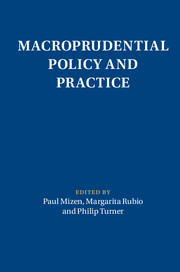Book contents
- Macroprudential Policy and Practice
- Macroeconomic Policy Making
- Macroprudential Policy and Practice
- Copyright page
- Contents
- Contributors
- Introduction
- 1 The Macroeconomics of Macroprudential Policies
- 2 A Liquidity-Based Approach to Macroprudential Policy*
- 3 Financial Intermediation and Monetary and Macroprudential Policies
- 4 The New Art of Central Banking
- 5 The Macroprudential Countercyclical Capital Buffer in Basel III
- 6 On the Use of Monetary and Macroprudential Policies for Small Open Economies
- 7 Capital Flows and Macroprudential Policy
- 8 Macroprudential Policy in a Globalised World
- 9 Systemic Risk of European Banks
- 10 Macroprudential Tools of Systemic Risk Analysis
- 11 When Is Macroprudential Policy Effective?
- 12 Macroprudential Policy
- Index
- References
5 - The Macroprudential Countercyclical Capital Buffer in Basel III
Implications for Monetary Policy
Published online by Cambridge University Press: 09 August 2018
- Macroprudential Policy and Practice
- Macroeconomic Policy Making
- Macroprudential Policy and Practice
- Copyright page
- Contents
- Contributors
- Introduction
- 1 The Macroeconomics of Macroprudential Policies
- 2 A Liquidity-Based Approach to Macroprudential Policy*
- 3 Financial Intermediation and Monetary and Macroprudential Policies
- 4 The New Art of Central Banking
- 5 The Macroprudential Countercyclical Capital Buffer in Basel III
- 6 On the Use of Monetary and Macroprudential Policies for Small Open Economies
- 7 Capital Flows and Macroprudential Policy
- 8 Macroprudential Policy in a Globalised World
- 9 Systemic Risk of European Banks
- 10 Macroprudential Tools of Systemic Risk Analysis
- 11 When Is Macroprudential Policy Effective?
- 12 Macroprudential Policy
- Index
- References
Summary
Basel III is a comprehensive set of reform measures in banking regulation, supervision and risk management with a strong macroprudential component, which has the aim of preventing future crises by creating a sound financial system. Nevertheless, these changes on financial regulation have to co-ordinate with monetary policy. We address several key research questions. First, we analyse how the higher capital requirements implied by Basel I, II and III affect welfare for a given monetary policy of different agents in the economy. Second, we study how these regulations affect the way monetary policy needs to be conducted. Finally, we propose an automatic rule to implement the macroprudential countercyclical buffer in Basel III and find the optimal parameters for this rule and for monetary policy. We conclude that a Pareto-superior outcome can be reached using the optimal values, and the macroprudential objective can be achieved.
- Type
- Chapter
- Information
- Macroprudential Policy and Practice , pp. 108 - 134Publisher: Cambridge University PressPrint publication year: 2018
References
- 2
- Cited by



